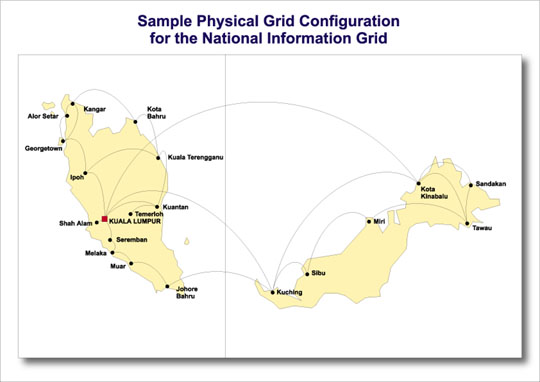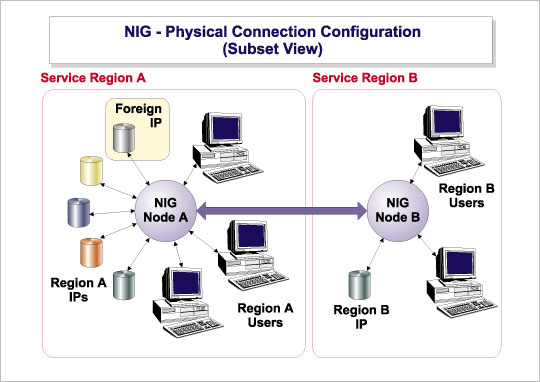2.4 NIG - Physical Aspects
A physical infrastructure will be needed to support the logical functions
of the NIG described in the previous sections of this chapter. In
broad terms, the physical part of the NIG consists of two major physical
components:-
- The NIG operator’s data centre facilities (nodes)
- The telecommunication carrier providers (telcos)

Figure 2-4. Combination of nodes and the communication lines of telecommunication companies: a distributed processing, client-server network. (View larger version: 68k.)
The first component is the one operated by the NIG Operator company. This is basically a series of data centres placed in major cities and towns or in other words, areas of high human population. These data centres are known as nodes. The local area each node services is known as a service region. Each data centre will have computer and other related hardware to provide users a local connection point to the NIG within each service region.
The equipment and software at each node will be capable of doing the following:
- Provide NIG connections for users and Information Providers within the service region.
- Receive information queries and facilitate on-line, interactive sessions for users through common user interfaces.
- Interrogating and retrieving accessible information of all types (narrowband, wideband and broadband) from the data centres of various Information Providers throughout Malaysia (and other countries).
- Store, process and forward IP data to users in formats suitable for delivery through various mechanisms.

Figure 2-5. Connecting NIG Nodes, Information
Providers (IPs) and Users
Providing the physical communication links between the NIG nodes, IPs and users is the second major component - the telecommunication companies (telcos). When combined with the telcos’ physical grid of communication lines and switches, the NIG nodes become part of a physical grid spread across the country as shown in Figure 2-4. Therefore, in Information Technology (IT) terms, the physical NIG is known as a network of distributed processing centres working in a true client-server fashion.
Whereas the logical aspects of the NIG provides resilience in information delivery, this physical aspect provides the resilience in information transportation and all aspects combined will provide resilience in information accessibility.
As a more detailed view of the physical grid, Figure 2-5 shows the connection
of nodes, IPs and users in a sample service region and the connection between
nodes in separate service regions. It also shows the possible variation
of size and complexity of each service region.
An additional physical aspect of the NIG is its utilisation of all
available telco networks in the country as shown in Figure 2-6 below.

Figure 2-6. Enhanced reliability through the
use of several telcos
With a choice of several telcos through which users can gain access to the NIG, it becomes a very reliable public service that is available virtually every hour of every day to serve the needs of our future Information Society and economy.
